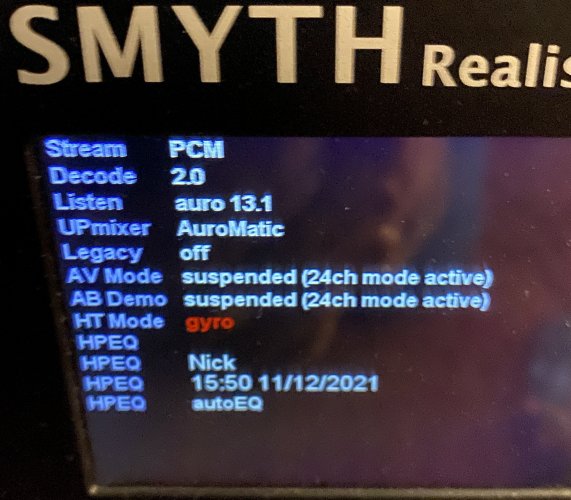I noticed it has HDMI input as well, so can I use my multi format music player like my Oppo to play back DVD-A, SACD or BDs in full 5.1 via the HP's? Say after I measured my own HT?
Correct.
The original A8 first released in 2009 (like my #0001 A8) had only 8-channel analog RCA inputs and didn't contain imbedded codecs. So you had to do your own upstream decoding in your AVR which hopefully had 7.1 multi-channel pre-amp output which you then fed to the 7.1 analog inputs of the original A8. There is also a corresponding set of 8-channel analog outputs supporting "straight-through analog bypass mode" when the Realiser is powered off. My original Yamaha RX-V863 (which is an analog-centric AVR) was part of my 2009 setup.
The analog-input A8 had an analog-to-digital stage to handle this converting 7.1 channel analog input to digital, with the following SVS processing occurring in digital domain. The output of SVS destined for stereo headphones was delivered both (a) still in 2-channel digital directly to the optical output (if you wanted to feed your own external DAC, which fed your headphone/amp), and (b) to its own built-in DAC and amplifier and stereo analog headphone outputs (both L/R RCA on the rear, as well as 3.5mm stereo minijack on the front).
In 2012, an upgrade to the A8 added HDMI input (and matching HDMI pass-through output), thus eliminating the analog-to-digital process entirely. Instead, discrete multi-channel LPCM was expected to be delivered via HDMI from an AVR or other source device which could both decode and deliver discrete multi-channel LPCM via HDMI. As it turns out, the Oppo players are pretty much the only consumer device I've heard about which have this capability (which is also why I bought an Oppo 103 in 2013, when I also bought a second A8 Realiser which included the HDMI feature). So decoding was still required externally upstream, but discrete decoded multi-channel LPCM could at least now be accepted into the A8 via HDMI.
In fact that's how I have my 103 set up, delivering video-only via HDMI1 output to my Yamaha RX-V867 AVR. I deliver audio-only decoded LPCM via HDMI2 output to the HDMI input of my A8. So playing 2-channel CD music, or 5.1/7/1 multi-channel BD/DVD discs with either lossy/lossless audio are all delivered decoded digital LPCM to the A8 for listening.
I also use have my home DVR feeding the rear HDMI input of my 103. This allows HDTV DD5.1 audio to also be decoded to LPCM by the 103 and also delivered to the A8.
So having an Oppo player with its two external HDMI inputs, and its two HDMI outputs, this represents the IDEAL source device feeding the A8... which did not have its own built-in codecs. This avoided requiring firmware upgrades to the A8 as new audio codecs come out, as it is simply the job of the Oppo AVR to do this heavy lifting and deliver decoded LPCM.
This subject has been addressed with the A16, which now contains built-in decoding support for all of the modern lossy/lossless audio formats, including the very latest 16-channel varieties. So you can simply now connect any HDMI source device directly to the A16 if you want.
Certainly if a new codec is relevant that's not supported by the Oppo but is supported by the A16, you'd use that same cabling approach and configure the Oppo to deliver the still-encoded HDMI audio from Oppo to the Realiser via "bitstream". But otherwise, for standard 5.1/7/1 audio that utilizes an Oppo player and an A16, you now have the option of just delivering everything "bitstream" and letting the A16 handle it all, always. Or, for codecs handled by the Oppo you also have the option of letting it do the decoding to LPCM and deliver it that way to the A8/A16.

























